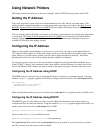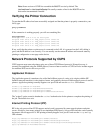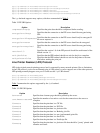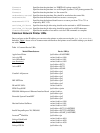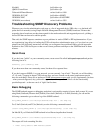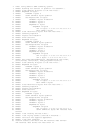
Kodak® lpd://address/ps
QMS® CrownNet
TM
lpd://address/ps
Tektronix® PhaserShare
TM
socket://address:9100
XEROX® 4512 NIC lpd://address/PORT1
XEROX® XNIC lpd://address/PASSTHRU
XEROX® (most others) socket://address:5503
Troubleshooting SNMP Discovery Problems
Whenever you view the administration web page or a list of supported device URIs, the snmp backend will
probe the local network(s) using Simple Network Management Protocol (SNMP) broadcasts. Printers that
respond to these broadcasts are then interrogated for the make and model and supported protocols, yielding a
device URI that can be used to add the printer.
That said, the SNMP requests sometimes expose problems in vendor SNMP or IPP implementations. If you
are experiencing long delays in loading the CUPS web interface administration page, or if you don't see your
printer listed, the following instructions will help you to diagnose those problems and/or provide important
feedback to the CUPS developers so that we can correct problems and improve the SNMP backend in future
releases.
Quick Fixes
If you don't use "public" as your community name, create a text file called /etc/cups/snmp.conf and put the
following line in it:
Community your community name
If you have more than one community name, list them all on separate lines.
If you don't support SNMP v1 on your network, you are currently "out of luck". That said, we will be adding
v2, v2c, and v3 support in future CUPS releases once we have a handle on the actual requirements people
have for such things. Please file or update an SNMP enhancement request with specific requirements you have
- what you need supported, why you need it supported, and how you would like to see the functionality
provided/exposed - so that we can do it "right" the first time.
Basic Debugging
The SNMP backend supports a debugging mode that is activated by running it from a shell prompt. If you are
using Bash (/bin/bash), Bourne shell (/bin/sh), Korn shell (/bin/ksh), or Z shell (/bin/zsh), you can run the
following command to get a verbose log of the SNMP backend:
CUPS_DEBUG_LEVEL=2 /usr/lib/cups/backend/snmp 2>&1 | tee snmp.log
For C shell (/bin/csh) and TCsh (/bin/tcsh), use the following command instead:
(setenv CUPS_DEBUG_LEVEL 2; /usr/lib/cups/backend/snmp) |& tee snmp.log
On MacOS X you'll find the SNMP backend in /usr/libexec/cups/backend instead:
CUPS_DEBUG_LEVEL=2 /usr/libexec/cups/backend/snmp 2>&1 | tee snmp.log
The output will look something like this:
1 INFO: Using default SNMP Address @LOCAL



